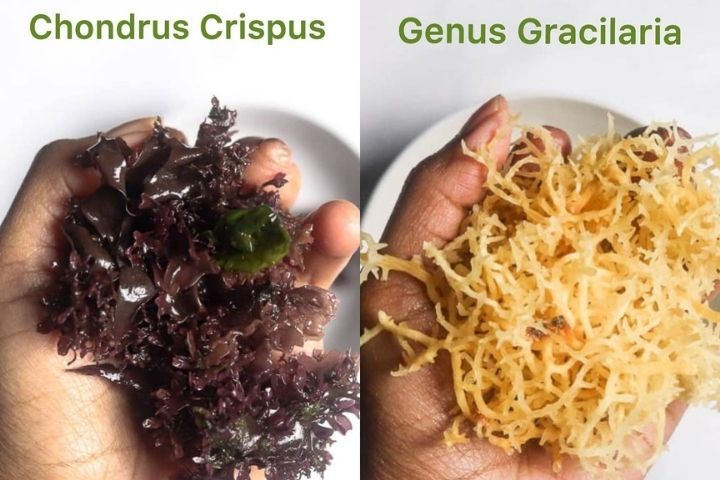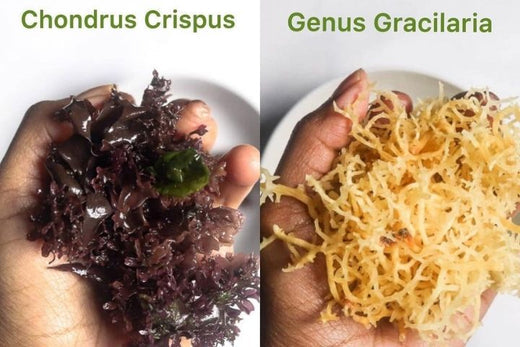
Irish Moss vs. Sea Moss: Does it Really Matter?
Last updated on December 28, 2022

If you’ve been recently introduced to the sea moss superfood trend, chances are you’re a bit confused by all the different names people mistakenly use for it.
Sea moss, Irish moss, Jamaican moss, Caribbean moss, Carrageenan moss: What’s the difference? Are they all the same seaweed? Why do we use different names?
Unfortunately, the answers aren’t that simple, and there’s definitely a need to bring some clarifications and finally get things straight. You have the right to know what you’re buying. And, as a sea moss company, we owe you detailed, reliable, and accurate information.
Simply put, whether Irish, Jamaican, or Caribbean, sea moss is sea moss. Scientifically, we’re talking about the exact same seaweed: Chondrus crispus.
However, studies have shown that sea moss’s geographical origin may impact its nutrient density and diversity. And that’s where the difference is relevant because nutrients are exactly why sea moss has such a significant impact on your health.
So, let's browse the similarities and differences between Irish, Caribbean, Jamaican, and other sea mosses. And most importantly, does it really matter?
Related article: What are sea moss benefits for health?
Where Does Sea Moss Come From?
Sea moss is scientifically known as Chondrus Crispus. Following the official botanical classification, this edible seaweed belongs to the Rhodophyta division (red algae), the Florideophycae class, the Gigartinales order, and the Gigartinaceae family. Now, sea moss may be called differently depending on where it grows.
Related article: How is sea moss different from other seaweeds?
Sea Moss (Chondrus crispus)
Sea moss is the generic name for any Chondrus crispus seaweed, independently of where it comes from. In other words, Irish moss, Jamaican moss, and Caribbean moss are all sea moss.
Sea moss has been used in traditional medicine and beauty products for centuries. It potentially contains 92 of the 102 minerals and vitamins our body needs to function. This exceptional nutrient variety and density make it one of the best superfoods with numerous health and wellness benefits, including heart health, diabetes, weight loss, immunity boosting, fertility, skin health, and others.
All kinds of natural, wildcrafted sea moss (Chondrus crispus) look like tangled and disorganized seaweed, with a haphazard mesh and spongy appearance.
Sea moss has various shades and colors, including brown, yellow, gold, purple, red, green, pink, or black. The color indicates the presence and concentration of certain natural compounds like phytonutrients, vitamins, minerals, and antioxidants. It’s highly influenced by the water and environment in which the seaweed has grown. But whether gold, purple, or green, sea moss is still the same plant, botanically speaking.
Related article: The differences between purple, gold, and green sea moss
Irish moss
Irish moss is sea moss naturally found along the northern Atlantic coasts of Ireland and New England, hence its name. It's also commonly referred to as "Irish sea moss." Irish moss grows abundantly on the west coast of Ireland, specifically in the Aran Islands, in Connemara.
Irish moss has been used in traditional Irish medicine for centuries, especially as a natural remedy for flu-like viruses, to make cough syrup, combat mucus, treat respiratory conditions, and reinforce the immune system. It was also an essential source of nutrition for the Irish people during the Great Famine in the mid-19th century.
Caribbean and Jamaican moss
Sea moss also grows in abundance in the Caribbean region, where it’s commonly called Caribbean moss or Jamaican moss.
While it’s botanically the same seaweed as Irish moss (sea moss) and belongs to the Chondrus crispus species, Caribbean moss has a slightly different nutrient composition. That's because it grows in warmer waters and absorbs different minerals and phytonutrients.
The Irish immigrant laborers introduced sea moss to the Caribbean islands. The Jamaicans traditionally boil it in milk and mix it with spices to make Jamaican moss drink. This health concoction is primarily used as an aphrodisiac sex elixir to boost men’s libido and a beauty product for skin and hair.
Saint Lucia sea moss
Saint Lucia sea moss is sea moss harvested in Saint Lucia, an island country located in the Caribbean Sea.
Saint Lucia sea moss is renowned worldwide for its superior quality. It grows in pristine waters, exceptionally rich in minerals.
At Organics Nature, we harvest wildcrafted sea moss in Saint Lucia in collaboration with the Agriculture Department to ensure we minimize our impact on the local ecosystem.
Carrageen moss
Carrageen moss is another name for sea moss. It’s a reference to Chondrus Crispus's high content of carrageenan, a natural gelatinous extract made of polysaccharides that makes up over 50% of sea moss weight.
Carrageenan is mainly used as a thickener and emulsifier in the food industry.
Related article: 10 tasty sea moss recipes to try today!
Irish Moss vs. Sea Moss
As mentioned above, Irish moss and sea moss are two different names for the same seaweed: Chondrus crispus. While sea moss is the generic name and can be used for any type of sea moss independently of where it comes from, Irish moss refers to sea moss harvested in Ireland. Similarly, Jamaican moss refers to sea moss from Jamaica. But are there any differences between these sea mosses? Does the origin of sea moss impact its look, quality, and health benefits?
Is Irish moss the same as sea moss?
Botanically speaking, Irish moss is the same as sea moss. However, regarding nutrients and health properties, Irish moss may have some specificities over other types of sea moss.
As we have shared in previous blogs, collagen is a protein associated with the entire body's function, especially the skin. Like any type of sea moss, Irish moss is rich in collagen-boosting proteins that help increase the body’s natural collagen production. So regardless of whether your sea moss is harvested in Ireland, Jamaica, or elsewhere, Chondrus crispus is always an excellent plant-based source of collagen.
Another similarity all sea moss share, independently of their geographical origin, is their high anthocyanin content. These powerful antioxidants from the flavonoid family are the ones that give a purple, pink, or blue color to some sea moss.
Sea moss that grows in warmer waters contains more anthocyanin than others. So, naturally, Jamaican or Caribbean moss, especially the ones from Saint Lucia, have more anthocyanin than Irish moss.
As a result, these sea mosses have increased antioxidant properties, so they’re even more efficient in reducing inflammation, promoting heart health, managing diabetes, preventing some sorts of cancer, and combating free radicals in the body.
Aside from sea moss, anthocyanin can be found in fruits and vegetables such as purple cabbage, eggplant, and berries, for example.
Irish vs. Caribbean: which is better?
Irish moss has long been seen as a superior sea moss, but it’s not necessarily true. Caribbean sea moss from Saint Lucia has gained increased popularity lately. It's proven to be the purest, with the highest nutrient diversity and density.
Ultimately, the differences between sea moss, Irish moss, and Jamaican moss are small and subtle. They all share similar properties. Independently of its origins, Chondrus crispus is very rich in nutrients, and consuming it regularly will provide significant benefits for your health.
Avoid fake pool-grown sea moss
The most important thing is to ensure you're purchasing real, organic, wildcrafted sea moss. Unfortunately, the market is flooded with fake sea moss.
Fake sea moss is industrially pool-grown. But pool farming fails at replicating the natural conditions of the ocean. As a result, the sea moss that comes out is nutritionally very poor. It contains very few nutrients and has minimal health benefits. In addition, laboratory tests on fake sea moss have shown it often contains dangerous chemicals and toxic products.
Related article: How to tell the difference between real and fake sea moss?
Chondrus crispus vs. Gracilaria
Finally, let's close the topic with a common mistake you often encounter when reading about the differences between Irish moss and sea moss online.
Everyone wants a say in the new sea moss trend, but not everyone is a qualified scientist or botanist. Actually, most self-proclaimed online sea moss experts lack basic knowledge about seaweeds.
A widespread confusion is about the relationship between Chondrus crispus and Genus Gracilaria, which are said to be two different species of sea moss. It's a mistake. Chondrus crispus and Gracilaria are distinct seaweeds.
While they belong to the same division (Rhodophyta) and class (Florideophyceae), they do not belong to the same order. Gracilaria is a gracilariales seaweed, while Chondrus crispus (sea moss) is a gigartinales one. Although they may look alike and share some characteristics, Gracilaria is not a species of sea moss.
Organics Nature only sells real sea moss (Chondrus crispus).
We hope this article has shed some light on what sea moss is and what it is not. Please, do not hesitate to reach out in the comment section below if you have any doubts or questions!






8 comments
Dear Gabrielle,
You can see our latest lab testing here: https://cdn.shopify.com/s/files/1/0274/4601/8115/files/heavy_metals_analysis_report.pdf
Best regards,
Organics Nature
Do you have proper certification for your seamoss? I’d like to see it before I purchase
Dear Leroy,
All our sea moss is exclusively sourced from Saint Lucia!
Thank you,
Organics Nature
Do you use St. Lucia sea moss exclusively in all your sea moss product or do you use different types
Dear Rikki,
Sea Moss does naturally grow in Saint Lucia! In that case, it is called Caribbean moss, but it’s the same species as Irish moss (Chondrus Crispus).
Best regards,
Organics Nature